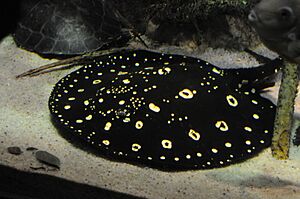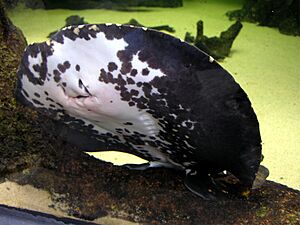Bigtooth river stingray facts for kids
Quick facts for kids Bigtooth river stingray |
|
|---|---|
 |
|
 |
|
| Showing upperparts (photo above) and underparts with mouth (photo below) | |
| Conservation status | |
| Scientific classification | |
| Synonyms | |
|
Trygon henlei Castelnau, 1855 |
The bigtooth river stingray or Tocantins River ray (Potamotrygon henlei) is a type of freshwater fish. It belongs to the family of Potamotrygonidae, which are river stingrays. This stingray lives only in certain rivers in Brazil. You can find it in the lower Tocantins and Araguaia basins. It likes to live on muddy river bottoms.
Sometimes, people keep these stingrays in aquariums. This stingray is usually common in its natural home. Its numbers even grew after the Tucuruí Dam was built. This is different from many other fish species in the area.
Meet the Bigtooth River Stingray
The bigtooth river stingray can grow quite large. Its body, which is called a disc, can be up to 71 cm (2.33 ft) wide. Its total length, including its tail, can reach about 104.2 cm (3.42 ft). That's over 3 feet long!
What Does It Look Like?
This stingray usually has a blackish or dark gray-brown body. It has yellowish-white spots on its upper side. Its underside is mostly white in the middle. The edges of its underside are brownish and dark.
Sometimes, you might even see bigtooth river stingrays with brown blotches instead of spots. A famous British scientist and angler, Jeremy Wade, once caught one of these stingrays. It had a black body with yellow spots.
Its Relatives in Other Rivers
The bigtooth river stingray has several close relatives. They live in different rivers in Brazil.
- Potamotrygon rex: This stingray lives in the middle and upper Tocantins basin. It has yellow-orange spots that form circles.
- Potamotrygon leopoldi: This one is found in the Xingu River basin. It also has yellowish-white spots like P. henlei. However, P. leopoldi is a deeper black color. Its underside is mostly brownish and dark.
- Potamotrygon albimaculata: This relative lives in the Tapajós River basin. It has smaller yellowish-white spots compared to P. henlei.


